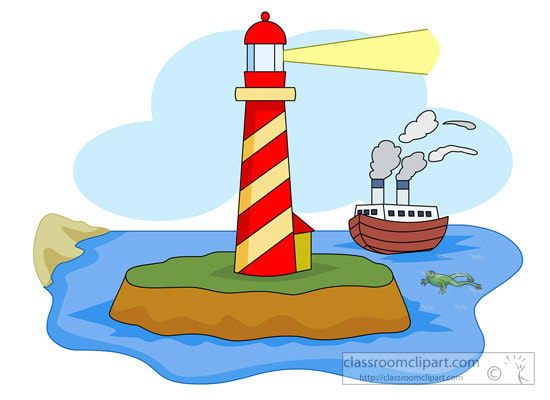August 7th is designated as National Lighthouse Day. But since tomorrow is the 7th and my wise teacher, the Dharma Frog will be here, I thought I'd use today's blog to celebrate a few fun facts about lighthouses.
1. The first lighthouse was Egypt's Pharos of Alexandria built in the third century BC. The lighthouse of Alexandria was made from a fire on a platform to signal the port's entry. One of the Seven Wonders of the Ancient World, it was one of the tallest man-made structures in the world for many centuries.
2. The world's oldest existing lighthouse is considered to be The Tower of Hercules. A UNESCO World Heritage Site that marks the entrance of Spain‘s La Coruña harbor. The lighthouse, which was erected in the first century, is still operational.
3. The tallest lighthouse is the Jeddah Light in Jeddah, Saudi Arabia. It measures 133 meters tall. a little over 436 feet tall. It is a concrete and steel lighthouse built in 1990 and marks the end of the outer pier on the north side of the entrance to the city’s seaport. It has a range of 46 kilometers (28.5 miles) and emits three white flashes every 20 seconds.
4. The most expensive lighthouse that has been built in the US is Saint George Reef, located near Crescent City, CA. It took 10 years to construct and cost $715,000.
5. In 1759 an engineer named John Smeaton designed a new type of lighthouse. It became a model for most lighthouses that followed. The lighthouse was built from interlocking blocks of stone instead of wood. This strengthened the structure so it could withstand powerful waves.
6. Originally, lighthouses were merely light with open fires, then candles, lanterns, and electric lights. Lanterns generally used whale oil as fuel. The Swiss scientist Aime Argand revolutionized lighthouse illumination in 1782 when he invented the smokeless flame. Early models used ground glass which was sometimes tinted around the wick.
7. In 1821, the French physicist Augustine Fresnel developed a new kind of lens that capture 85% of the light emitted from the illuminant. He developed seven different sizes (that he called orders) and the sizes of the lenses & their effective range decrease as the order number increases.
8. Lighthouse keepers were paid a lower middle-class wage. George Worthylake, an early lighthouse keeper, received an annual salary of 50 pounds (about $250). Today, that would translate to a salary of $16,000 annually. During the 19th century, the Head Keeper’s pay ranged from $250 to $600, others were paid less. The exception to this was in the West, where keepers were paid $1,000 during the Gold Rush. The service supplied certain foodstuffs during most of their history.
9. Many of the lighthouse keepers were women. The US Lighthouse Society has 80 women lighthouse keepers recorded, but most took over the job when their husband or male relative died or became unable to perform the duties.
On National Lighthouse Day, we celebrate how these scenic, historic establishments have comforted travelers throughout the centuries. If you live near one, plan on visiting it soon. They're wonderful to see in photographs and paintings, but are even better when viewed up close and personal! Another way to celebrate National Lighthouse Day is to try your hand at painting one. No artistic skills? No problem. You can still celebrate the day by donating to The American Lighthouse Organization, an organization that is dedicated to preserving and protecting these historic structures. If you visit a lighthouse, consider making a small donation to its operating organization to continue public access.
As I mentioned earlier, Dharma will be here again tomorrow for another life lesson. Please plan on stopping by to see what he has in store for me. Who knows? It might be just what you need to solve one of your own problems. Until then, I wish you
PEACE.
http://justfunfacts.com/interesting-facts-about-lighthouses/

 RSS Feed
RSS Feed